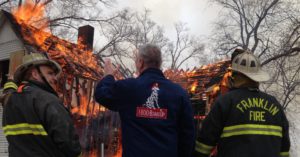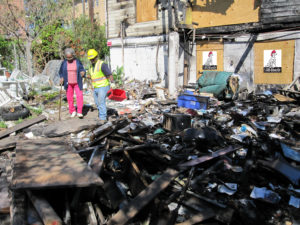A house fire can leave a family in anguish as they watch their home and possessions melt away within the flames. However, what many fire victims do not consider is that just because the fire is out does not mean entering the property soon after the fire is safe. House fires leave behind toxic environments that leave families with physical and mental health risks.
Toxic environments that linger after a fire is a leading concern for the International Association of Fire Chiefs, the International Association of Firefighters, and the National Fire Protection Association (NFPA). According to the Firefighter Cancer Support Network (FFCSN), cancer caused through continuous exposure to these toxic environments is the leading cause of death for firefighters, despite wearing PP and SCBA’s. So should fire victim citizens, without proper gear and training, be allowed back within their homes? 
The yardstick used by many fire departments to determine if civilians can return to their homes is “Do I need to pull power?” or “Is the fire/smoke damage enough to warranty property owner removal from the property?” Either way, remember that a new toxic environment exists within those walls. Once the fire or police department leaves the scene, the “control” of the home reverts to the homeowners. Since it is private property, the homeowner(s) have every right to return to their property unless it has been deemed structurally unsafe.
However, concerns pertaining to whether or not to allow citizens back on site after a fire increased after studies from Federal Emergency Management Agency (FEMA), FFCSN, and the NFPA showed increased risks of long-term health issues from after-fire toxic environments are higher in children and older citizens. This is because a child’s lungs are not fully developed, and the elderly typically have already medically-compromised or weakened immune systems.
Although it would be convenient to allow families to stay within their homes, removing smoke particles within a timely manner to make the home safer for anyone who would enter the house is an essential step that is  usually overlooked by homeowners. This helps limit effects on still-developing lung tissue and those with compromised respiratory systems, such as with children and the elderly.
usually overlooked by homeowners. This helps limit effects on still-developing lung tissue and those with compromised respiratory systems, such as with children and the elderly.
Insurance typically helps cover the costs of scrubbing the walls, ceilings and floors. However, it is rare that they also cover the cleaning of the HVAC system and soft fabrics, such as bedding and furniture. This service benefits fire victims for not only health reasons, but for psychological reasons as well. Imagine feeling your life is finally getting resettled several months afterwards; the trauma has subsided. Then, the family opens a drawer full of uncleaned clothes, the smoke smell hits them again, and they are mentally right back to the day the fire happened and the trauma starts anew.
You have read a story like this a hundred times before. In fact, you have seen it before. Residential fires can lead to significant emotional distress in addition to possible physical injuries. Losing a home in a fire involves not only the loss of someone’s residence, but also many other things of value, such as photo albums, important documents, and treasured items. After a fire, the sense of security a family feels within their home can be lost and can significantly disrupt the normality of daily life.
However, there are so many resources available for fire victims and the firefighters finding it difficult leaving them behind. At 1-800-BOARDUP, we provide scene security, hotel, meals, pet care, clergy, Victim Advocate’s guides, cell phones , and victim bags that contain necessary toiletry items. Although we stand behind our program as being the best of the best, there are many others that also help fire victims:
- American Red Cross
- Salvation Army
- Public agencies, such as the public health department
- Community groups
- State or municipal emergency services offices
Do not leave an emergency scene without talking to the victims about these resources and making a call yourself. Protect your community even when you must respond to another emergency. Their mental and physical health can be at risk.
Sources:
–https://www.uphelp.org/sites/default/files/publications/returning_to_your_home_after_a_wildfire.pdf
– https://www.usfa.fema.gov/downloads/pdf/publications/fa_46.pdf
